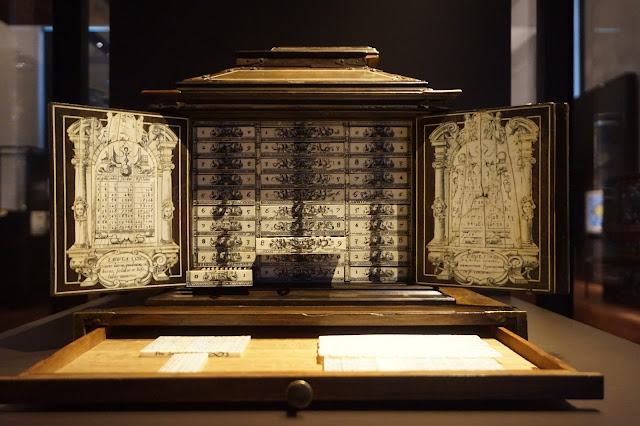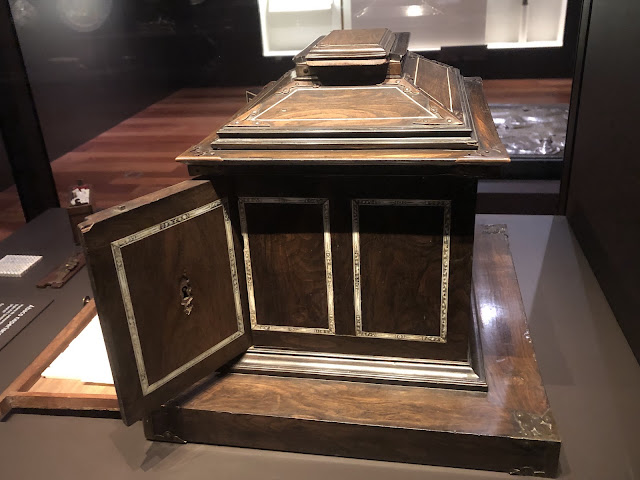 |
| Sforza Castle, Milan, Italy |
Leonardo da Vinci worked for various patrons in various cities over the course of his life. One of these patrons was Ludovico Sforza, and one of these cities was Milan, where Sforza ruled as duke. The pictures above and below are of Sforza Castle.
 |
| Sforza Castle, Milan, Italy |
Leonardo (1452-1519) first worked in Milan from 1482 to 1499 and then again from 1508 to 1513. And though his patron was Ludovico Sforza, he was free to take commissions from others while there. One of these was the painting The Virgin of the Rocks (the one that is now in the Louvre).
 |
| Madonna of the Rocks, Leonardo da Vinci (Louvre) |
Another commission was that of The Last Supper, which he painted for the monastery of Santa Maria della Grazie.
 |
| Leonardo da Vinci's Last Supper, Santa Maria della Grazie, Milan |
 |
| Santa Maria della Grazie, Milan, Italy |
 |
| Santa Maria della Grazie, Milan, Italy |
Before moving on to Leonardo's mathematical consultants, I want to share one more of his works that is in Milan - one I had not heard of before traveling here. This one is found inside the Sforza Castle. It's in a room, or I should say, "IS the room" of Sala della Asse.
 |
| Salla della Asse, Castello Sforzezco, Milan, Italy |
It's hard to make out, but this fresco on the walls and ceiling are of intertwining plants and trees and is intended to make the room seem to be an outdoor setting rather than an interior room. The intent was for it to look like a grove of mulberry trees. It doesn't help that my pictures were taken over and around barriers blocking the opening to the room which is undergoing renovations. The painting dates to about 1498.
 |
| Salla della Asse, Castello Sforzezco, Milan, Italy |
 |
| Salla della Asse, Castello Sforzezco, Milan, Italy |
While in Milan, Leonardo met mathematician Luca Pacioli. Pacioli had been invited to work in Milan by Duke Ludovico Sforza in 1497, but Leonard already know of Pacioli and had purchased his book
Summa arithmetica in 1495 - one of the most expensive books in Leonardo's library. Pacioli became a geometry tutor and collaborator to Leonardo. The collaboration was extensive, and though they were forced to leave Milan in 1499 due to war with France, their paths did not separate until 1506.
 |
| Portrait of Luca Pacioli (attributed to Jacopo de' Barbara - source: Wikipedia - Public Domain) |
Pacioli was born in Sansepolcro in the Republic of Florence in about 1447 (making him 5 years Leonardo's senior). As well as being a mathematician, he was also a Franciscan friar and is considered the father of accounting and bookkeeping. In the mid-1460s, Pacioli lived in Venice where he worked as a mathematics tutor. It was during this time that he wrote his first book, a book of arithmetic for the boys he was tutoring. About 10 years later, he moved to Perugia. He continued to work as a private tutor there until become the first chair of mathematics at the university there. One of Pacioli's books,
Divina proportione (
Divine proportion) was completed during his time in Milan (1498), and it was illustrated by Leonardo da Vinci. I don't know of any other mathematicians who can claim the honor of having one of their books illustrated by da Vinci!
 |
| Vitruvian Man by Leonardo da Vinci (Public Domain - retrieved from Wikipedia) |
One topic of conversation between Leonardo and Fazio was that of optics and perspective. Fazio had edited the first printed edition of a book the topic of optics, Perspectivo communis by John Peckham (1230-1292), which was the first printed book that included diagrams (beating out even Euclid's Elements for that distinction). Leonardo mentions Fazio Cardano in his notebooks many times, especially in the form of reminders to himself to ask for one or another book on proportions.
 |
| Leonardo da Vinci's Last Supper, Santa Maria della Grazie, Milan |
Circling back around to Leonardo's Last Supper, we see his use of perspective as the room in which the supper is being held recedes into the distance. The painting is on the wall of the refectory where the monks of the day would have eaten. The perspective of the painting would make it look as if the monks were joining the disciples in the Last Supper.
 |
| Leonardo da Vinci's Last Supper, Santa Maria della Grazie, Milan |
 |
| Leonardo da Vinci's Last Supper, Santa Maria della Grazie, Milan |
Young Girolamo Cardano, who would grow up to be one of the most prominent mathematicians of the 16th century, was used by his father Fazio as a bit of pack mule - having him carry his bags as Fazio went about his business. This included visits to Leonardo. As a teenager, Girolamo Cardano met Leonardo da Vinci and saw the Last Supper.
 |
| Leonardo da Vinci's Last Supper, Santa Maria della Grazie, Milan |
In one of my readings on Girolamo Cardano (and sadly, I can't remember which one) he comments that when he visited the Last Supper somewhat later in life that Leonardo's masterpiece was already disintegrating mere decades after he painted it. It is on Girolamo Cardano that my travels in northern Italy are focused, but it's pretty cool that I get to "meet" other folks along the way - other folks such as Pacioli, Fazio, and, not least, Leonardo da Vinci.
Oh, and before concluding, I should mention that a significant portion of Leonardo da Vinci's notes - the Codex Atlanticus - reside in Milan's Biblioteca Ambrosiana. Here you can find a room dedicated to this codex and with pages from it on display.
 |
| Biblioteca Ambrosiana, Milan |
 |
| Biblioteca Ambrosiana, Milan |
 |
| Biblioteca Ambrosiana, Milan |
 |
| Detail of da Vinci notes from Codex Atlanticus, Biblioteca Ambrosiana, Milan |
 |
| Detail of da Vinci notes from Codex Atlanticus, Biblioteca Ambrosiana, Milan |
 |
| Detail of da Vinci notes from Codex Atlanticus, Biblioteca Ambrosiana, Milan |
 |
| Detail of da Vinci notes from Codex Atlanticus, Biblioteca Ambrosiana, Milan |
 |
| Detail of da Vinci notes from Codex Atlanticus, Biblioteca Ambrosiana, Milan |
 |
| Detail of da Vinci notes from Codex Atlanticus, Biblioteca Ambrosiana, Milan |
 |
| Detail of da Vinci notes from Codex Atlanticus, Biblioteca Ambrosiana, Milan |
Just before getting to the room containin the codex, there is a room containing paintings by da Vinci and early copies of da Vinci works. Below are a couple of examples.
 |
| Biblioteca Ambrosiana, Milan |
 |
| Biblioteca Ambrosiana, Milan |









































































